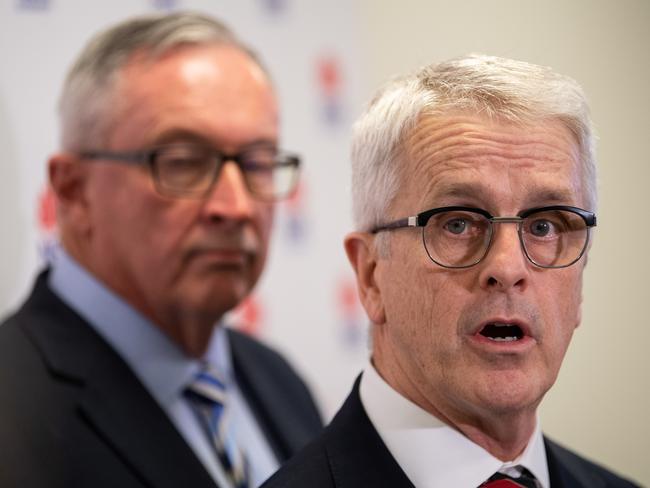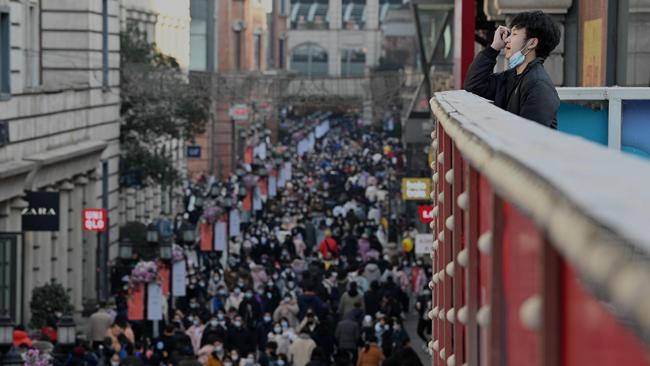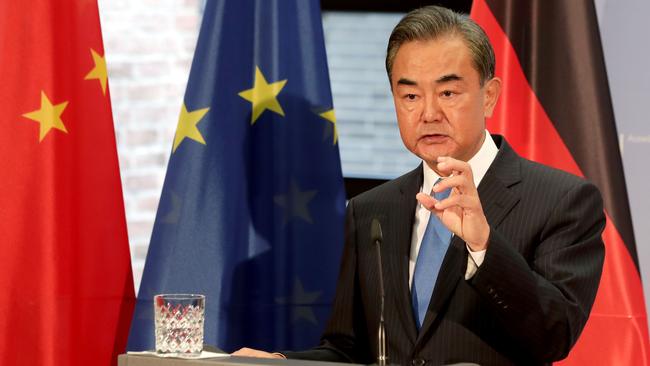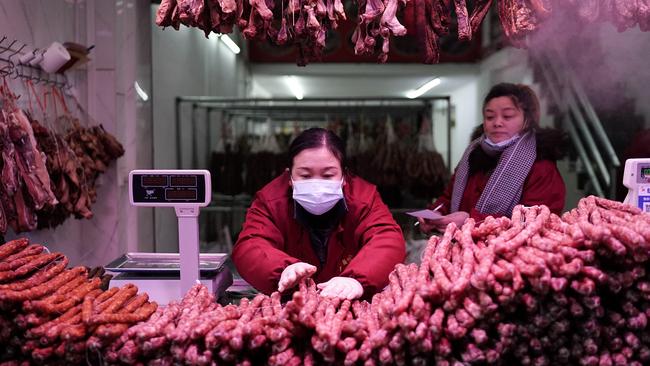Coronavirus: Scientists cast doubt on WHO’S China mission to find COVID-19 origin in Wuhan
International experts — including an Australian — are about to start investigating the orgins of COVID-19 in Wuhan after months of delays and denials from China.

In the coming days, bar any last-minute hitches, 10 renowned international scientists will check into Chinese hotel rooms for two weeks of quarantine.
So will start the World Health Organisation mission of foreign experts to investigate the coronavirus, a year after the first reports emerged of a mystery disease sweeping the central city of Wuhan.
The stakes could not be higher in the hunt for the origins of the greatest public health challenge of our era, amid persistent warnings that the world needs to prepare for many more deadly pandemics.
But the mystery has become even harder to solve. Beijing has delayed the arrival of the WHO team for months with a barrage of logistical demands and rules.
The experts will depend on government co-operation for access to interviews, data, samples and facilities at a time when Beijing is determined to trumpet its handling of the coronavirus as a stellar success.

Even before new evidence emerged last week of the scale of Beijing’s concealment and cover-ups, some critics were predicting that the Chinese-approved WHO mission would be a whitewash. They have focused on the prominent role on the team of Peter Daszak, a British zoologist who heads the US-based EcoHealth Alliance, a global health research charity.
As an expert in zoonotic diseases, which spread from animals to humans, and with long experience of researching bat-borne coronaviruses in southern China, he seemed a natural choice for the WHO mission.
But he has become a lightning rod for critics of the investigation. For 15 years, Daszak worked closely with the Wuhan Institute of Virology on bat and coronavirus research. Some have argued that the laboratory should be investigated as the possible accidental source, via a leak or infection, of the outbreak just a few kilometres from its high-security walls.
Daszak was a frequent traveller to Wuhan and the bat colonies of Yunnan with WIV scientists on projects funded by EcoHealth with US grants — until the Trump administration abruptly severed support, citing bio-security concerns.
The British scientist has forcefully dismissed the scenario of a laboratory leak as “baloney” and a “conspiracy theory”, and praised the work of his Chinese counterparts, notably Shi Zhengli, the “bat woman” of Wuhan, who traced the origins of the earlier Sars coronavirus outbreak to a colony of horseshoe bats in Yunnan.
Richard Ebright, an American scientist and biosafety expert, said Daszak should be “disqualified” because of his ties to the WIV and his strong opinions on the lab mishap theory. “His inclusion makes it clear the WHO study cannot be considered a credible investigation and must be understood instead to be a crude whitewash,” Ebright said.
Daszak has rejected the criticisms, noting his work was public and that his collaboration with the WIV gave him important knowledge about the origins of bat coronaviruses in China.
The terms of reference for the mission make no mention of the WIV or the possibility of a laboratory leak. Shi told the BBC that the WHO team had already been in touch and would be “welcome” at the site.

Dominic Dwyer, an Australian virologist on the team, said members had been told that no sites, including the laboratory, would be off-limits. “Every suggestion and hypothesis is open for investigation,” he said. “We are scientists and researchers and our aim is to look at the science and try to ignore the politics, however sensitive.”
He acknowledged that breakthroughs might be limited. “There is every chance we won’t ever find patient zero or bat zero, but hopefully we can learn better how to react when another pandemic comes along.”
Dwyer echoed comments by other team members that they do not intend to assign blame — language that has raised concerns about the goals of the mission.
In Wuhan health officials initially identified a seafood and wildlife market as the place where the virus jumped from animals to humans after several hawkers fell sick with pneumonia-like symptoms.
But some early cases had no connection to the market. And China’s Centre for Disease Control later said that samples from the site indicated that it was not the source after all. The CDC did not share the material and so the basis for that assertion is not clear.
So the market was probably the first “super-spreader” event of the pandemic. And that leaves unknown where the pathogen emerged and for how long it had been circulating, possibly developing for months in a milder form, unrecognised, building its strength.

Bats are widely suspected to be the original reservoir — not least because they have been the source of COVID-19’s earlier cousins Sars and the Middle East respiratory syndrome (Mers). Many scientists have said that an intermediary “host” animal, infected by a bat, probably delivered the jump to people, but there is no evidence of the zoonotic spread.
In their attempt to investigate this mystery, the WHO experts will study human and animal samples collected by Chinese researchers and medical data provided by the authorities. The market itself has been scrubbed clean and samples were burnt to prevent infection.
After a year the task would be extremely difficult even without the international geopolitics, rows about the WHO and the trading of insults between Beijing and Washington.

A series of developments last week raised fresh questions about China’s lack of transparency and illustrated the scale of the challenge facing the WHO team. Foreign Minister Wang Yi claimed in an interview over the weekend that the pandemic had emerged via several outbreaks around the world.
He is the most senior official to voice the increasingly common claim that China identified the first cases but was not the source.
Mike Ryan, director of the WHO health emergencies program, has called it “highly speculative” to say the coronavirus did not emerge in China.
Documents obtained by the Associated Press revealed that President Xi Jinping had banned universities, medical agencies and laboratories from sharing COVID-19 data after two Chinese scientists published a paper suggesting the virus could have leaked from a lab.
Beijing ordered all COVID-19 research to undergo a review and approval process by a taskforce under the State Council, China’s cabinet. No significant data has been released from those studies.

A blunt message has been sent to any citizens brave enough to question the official narrative of transparency and success. Last week state television highlighted the “rebirth” of Wuhan as thousands of revellers filled the streets for New Year’s Eve celebrations and, in his January 1 speech, Xi championed the country’s handling of the pandemic.
But Zhang Zhan, a lawyer-turned-blogger, was sentenced to four years in prison for “picking quarrels and provoking trouble” — a catch-all accusation often used by the Communist Party to prosecute activists and journalists. She had chronicled Wuhan’s plight before she was censored and detained.
Three other independent journalists were arrested while working in Wuhan during lockdown. Two have not been seen since February.

Whistleblower doctors and scientists who raised early fears about the disease were silenced. And relatives of Wuhan victims who went public with grievances about the handling of the epidemic have been told to keep quiet.
One persistent complaint from Wuhan was that the government was concealing the scale of the outbreak. New CDC figures appear to confirm that belief. When the agency tested 34,000 people in Wuhan for coronavirus antibodies, it found a rate of 4.43 per cent. In a city of 11 million people, that means nearly 490,000 people were infected, dwarfing the official tally of 50,354 cases.

As the pandemic swept across the world and details of Beijing’s early bungling and cover-ups emerged, China strongly opposed calls for an independent international inquiry.
America was the most vocal critic, also taking aim at the WHO for being soft on Beijing, but Australia and Britain called for inquiries as well. Beijing agreed in May to a joint investigation led by the WHO, but negotiations about access dragged on for months. It has imposed a series of conditions, including vetting of the foreign experts, and insisted that the scope of the hunt for the origins should be global, not limited to China.
Even as investigators packed their bags for China this weekend, their hosts were insisting that the WHO search elsewhere.
Chinese officials, media and scientists have cherry-picked foreign research and raided the internet to argue that the virus may have originated in Spain or Italy, was bio-engineered in America or imported via frozen food packaging.
The Sunday Times




To join the conversation, please log in. Don't have an account? Register
Join the conversation, you are commenting as Logout